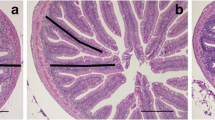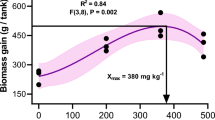Abstract
Atlantic salmon fingerlings were fed a vitamin C deficient diet for four months. The fish were then provided a dry, practical fishmeal based diet supplemented with 0, 500 or 5000 mg vitamin C/kg as L-ascorbic acid or equivalent amounts of ascorbate-2-sulfate. After six weeks on these diets ten fish in each group were injected with a soluble antigen (NIP11-LPH). Six weeks thereafter blood, liver, kidney, spleen and vertebrae were examined for trace elements. The livers were also analysed for metallothionein.
The vitamin C deficient fish were anemic despite the significantly elevated iron concentrations in the liver. Vitamin C had no positive effect in lowering tissue levels of cadmium. The highest level of dietary vitamin C given as ascorbic acid reduced the liver selenium concentrations. In response to antigen injection, the fish in all groups showed increased levels of hepatic metallothionein, copper, zinc and cadmium, while hepatic selenium and iron levels were less affected. The elemental composition in other organs was affected by the antigen injection to a minor extent.
Similar content being viewed by others
References cited
Albrektsen, S., Lie, Ø. and Sandnes, K. 1988. Ascorbyl palmitate as a dietary vitamin C source for Rainbow trout (Salmo gairdneri). Aquaculture 71: 359–368.
Banerjee, S. and Chakvabarty, A.S. 1965. Utilization of iron by scorbutic guinea pigs. Blood 25: 839–834.
Berman, S.S. 1984. ICES seventh round intercalibration for trace metals in biological tissue. ICES 7/TM/BT (Part 1). Preliminary Report, 64 pp.
Bridges, K.S. 1987. Ascorbic acid inhibits lysosomal autophagy of ferritin. J. Biol. Chem. 262: 14773–14778.
Dabrowski, K. and Köck, G. 1989. Absorption of ascorbic acid and ascorbic sulfate and their interaction with minerals in the digestive tract of rainbow trout (Oncorhynchus mykiss). Can. J. Fish. Aquat. Sci. 46: 1952–1957.
Dallinger, R. and Kautzky, H. 1985. The importance of contaminated food for the uptake of heavy metals by rainbow trout, (Salmo gairdneri): A field study. Oecologia 67: 82–89.
Fox, M.R.S. 1975. Protective effects of ascorbic acid against toxicity of heavy metals. Ann. N.Y. Acad. Sci. 258: 144–150.
Fox, M.R.S., Jacobs, R.M., Jones, A.O.L., Fry, B.E. and Stone, C.L. 1980. Effects of vitamin C and iron on cadmium metabolism. Ann. N.Y. Acad. Sci. 355: 249–261.
Hager, L.J. and Palmiter, R.D. 1981. Transcriptional regulation of mouse liver metallothionein-I gene by glucocorticoids. Nature, Lond. 291: 340–342.
Hamer, D.H. 1986. Metallothionein. Ann. Rev. Biochem. 55: 913–951.
Harrison, S.E. and Klaverkamp, J.F. 1989. Uptake, elimination and tissue distribution of dietary and aqueous cadmium by rainbow trout (Salmo gairdneri Richardson) and Lake white-fish (Coregonus clupeaformis Mitchill). Environ. Toxicol. Chem. 8: 87–97.
Haux, C. and Larsson, Å. 1984. Long-term sublethal physiological effects on rainbow trout, Salmo gairdneri, during exposure to cadmium and after subsequent recovery. Aquat. Toxicol. 5: 129–142.
Herlyn, D. and Glaser, H. 1976. Vitamin supply and immune response. Ubers. Tierernahrg. 4: 235–261.
Hilton, J.W., Cho, C.Y. and Slinger, S.J. 1978. Effect of graded levels of supplemental ascorbic acid in practical diets fed to rainbow trout (Salmo gairdneri). J. Fish. Res. Bd. Can. 34: 431–436.
Hilton, J.W. 1984. Ascorbic acid — mineral interactions in fish. In: Ascorbic Acid in Domestic Animals. pp. 218–224. Edited by I. Wegger, F.J. Tagwerker and J. Moustgaard. The Royal Danish Agricultural Society, Copenhagen.
Hilton, J.W. 1989. The interaction of vitamins, minerals and diet composition in the diet of fish. Aquaculture 79: 223–244.
Hornig, D., Glatthaar, B. and Moser, U. 1984. General aspects of ascorbic acid and metabolism. In: Ascorbic Acid in Domestic Animals. pp. 218–224. Edited by I. Wegger, F.J. Tagwerker and J. Moustgaard. The Royal Danish Agricultural Society, Copenhagen.
Julshamn, K. and Andersen, K.J. 1982. Subcellular distribution of minor elements in unexposed molluscs in Western Norway. I. The distribution and binding of cadmium, zinc and copper in the liver and the digestion system of the oyster (Ostrea edulis). Comp. Biochem. Physiol. 75A: 9–12.
Lall, S.P. 1989. The minerals. In: Fish Nutrition. pp. 219–257. Edited by J.E. Halver. Academic Press, San Diego.
Li and Lovell . 1985. Elevated levels of dietary ascorbic acid increase immune responses in Channel catfish. J. Nutr. 115: 123–131.
Maage, A. 1990. Comparison of cadmium concentration in Atlantic Salmon (Salmo salar) fry fed different commercial diets. Bull. Environ. Contam. Toxicol. 44: 770–775.
Maage, A., Sveier, H. and Julshamn, K. 1989. A comparison of growth rate and trace element accumulation in Atlantic salmon (Salmo salar) fry fed four different commercial diets. Aquaculture 79: 267–273.
Mazur, A. 1969. Mechanism of plasma iron incorporation into hepatic ferritin. J. Biol. Chem. 135: 595–603.
National Research Council. 1981. Nutrient Requirements of Coldwater Fishes. National Academy Press, Washington DC.
Navarre, O. and Halver, J.E. 1989. Disease resistance and humoral antibody production in rainbow trout fed high levels of vitamin C. Aquaculture 79: 207–221.
Olafson, R.W. and Sim, R.G. 1979. An electrothermal approach to quantification and characterization of metallothionein. Annal. Biochem. 100: 343–351.
Olsson, P.E., Haux, C. and Førlin, L. 1987. Variation in hepatic metallothionein, zinc and copper levels during an annual reproduction cycle in rainbow trout, Salmo gairdneri. Fish Physiol. Biochem. 3: 39–47.
Olsson, P.E., Larsson, Å., Maage, A., Haux, C., Bonham, K., Zafarullah, M. and Gedamu, L. 1989. Induction of metallothionein synthesis in rainbow trout, Salmo gairdneri, during exposure to cadmium in the water. Fish Physiol. Biochem. 6: 221–229.
Sandnes, K., Julshamn, K. and Braekkan, O.R. 1984. Interrelationship between ascorbic acid and trace elements in ovarian development in fish. In: Ascorbic Acid in Domestic Animals. pp. 213–217. Edited by I. Wegger, F.J. Tagwerker and J. Moustgaard. The Royal Danish Agricultural Society, Copenhagen.
Sandnes, K., Hansen, T., Killie, J.E.A. and Waagbø, R. 1990. Ascorbate-2-sulfate as a dietary vitamin C source for Atlantic salmon (Salmo salar): 1. Growth, bioavailability, haematology and immune response. Fish Physiol. Biochem. (this issue).
Sobocinski, P.Z., Canterbury, W.J., Knutsen, G.L. and Hauer, E.C. 1981. Effect of adrenalectomy on cadmium- and turpentine-induced hepatic synthesis of metallothionein and a2-macrofetoprotein in the rat. Inflammation 5: 153–164.
Tucker, B.W. and Halver, J.E. 1986. Utilization of ascorbate-2-sulfate in fish. Fish Physiol. Biochem. 2: 151–160.
Webb, M. 1979. The Metallothioneins. In: The Chemistry, Biochemistry and Biology of Cadmium. pp. 195–266. Edited by M. Webb. Elsevier/North Holland, Amsterdam.
Yamamoto, Y., Hayama, K. and Ikeda, S. 1981. Effect of dietary ascorbic acid on the copper poisoning in rainbow trout. Bull. Jap. Soc. Sci. Fish. 47: 1085–1089.
Yamamoto, Y. and Inoue, M. 1985. Effects of dietary ascorbic acid and dehydro-ascorbic acid on the acute cadmium toxicity in rainbow trout. Bull. Jap. Soc. Sci. Fish. 51: 1299–1303.
Author information
Authors and Affiliations
Rights and permissions
About this article
Cite this article
Maage, A., Waagbø, R., Olsson, P.E. et al. Ascorbate-2-sulfate as a dietary vitamin C source for Atlantic salmon (Salmo salar): 2. Effects of dietary levels and immunization on the metabolism of trace elements. Fish Physiol Biochem 8, 429–436 (1990). https://doi.org/10.1007/BF00003399
Issue Date:
DOI: https://doi.org/10.1007/BF00003399




